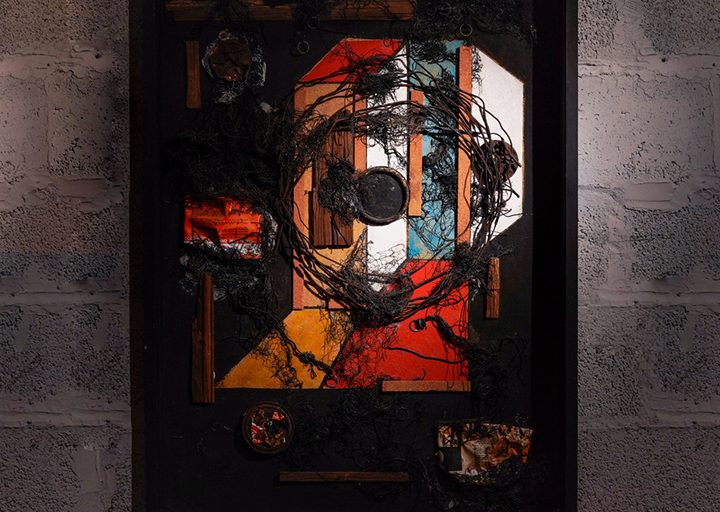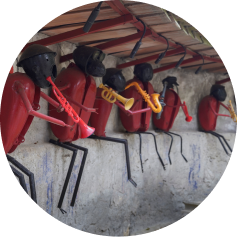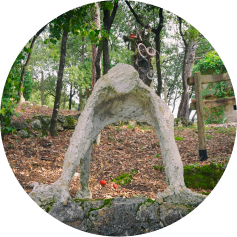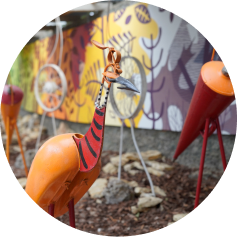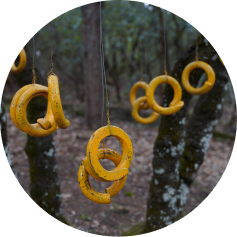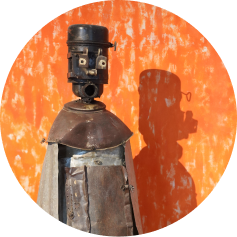
Le bare (Coffins), 1980
Le bare (Coffins), 1980
in this artwork, there is the alternation of two different techniques: geometric shapes and assemblage. This collection is composed of two pieces and it is made by Brajo Fuso during his latest artistic period. It recalls the destiny of each of us that cannot be escaped, representing death and the geometrical space in which the body will lie forever (the coffin). This is also a prediction for the artist, who died in 1980, the same year in which he made this collection.

Donna gestuale, 1946
Donna gestuale, 1946
In 1946, Brajo Fuso tests the dripping technique, recalling the psychical automatism techniques of surrealists. In this case, the image recalls the figurative debut of the painter, but at the same time, the abstract gestural expressiveness makes this painting a transition artwork to the mature artistic period.

Crocifisso (Crucifix), 1961
Crocifisso (Crucifix), 1961
The Crucifix of Brajo Fuso represents the sense of poverty connected to the symbol of Christ. In this case, poverty is represented by rusted iron scraps, enhancing the sense of simplicity of this artwork. At the same time, chains represent the tragedy of martyrdom.

Incidente stradale (Car accident), 1960
Incidente stradale (Car accident), 1960
Collecting wrecked cars is a recurring feature in post World War II art. From the French artist César to the American Chamberlain, until Brajo Fuso, artists collect wrecked cars and try to convey them a sense of beauty that can be found in simple things.

Algeria, 1957
Algeria, 1957
Accumulation of wood scraps recalls the French artistic genre of Nouveau Réalisme. With this artwork, Brajo experiences freedom of shape and colours, finding balance among the elements composing this artwork and making it independent and deeply descriptive.

Etruscolide
Etruscolide
The Etruscolidi collection is a representation of the Etruscan origin of the Umbria region. This collection of artworks is made of plastic pipes used for electrical systems, papier-mâché and other materials. Brajo Fuso, with this collection, pays homage to the Etruscan archaeological ruins in Umbria.

Vase similar to a totem, 1950
Vase similar to a totem, 1950
This artwork includes both traditional elements and breaking points in Brajo’s art. This vase is made of glazed ceramic, a technique that the artist learnt from the artisans of Etruria, a historical company of Perugia. Bright colours and an unusual shape recall Picasso’s style.

Carnevale (Carnival), 1947
Carnevale (Carnival), 1947
Masks are recurring elements in Brajo Fuso’s style. In this canvas, belonging to the figurative artistic period, Carnival is a celebration of the joy given by the multitude of colours and it represents the liberation of the individual.

Mobloggetto nero, 1964
Mobloggetto nero, 1964
Mobloggetto represents Brajo’s familiarity with Pop Art guidelines. The year of its creation, 1964, shows the attention of the artist to the contemporary art period. In fact, in the same year, the American artist Robert Rauschenberg wins the Golden Lion at the Venice Biennale, legitimising American art that was already spread in Europe and the world after the economic boom.

